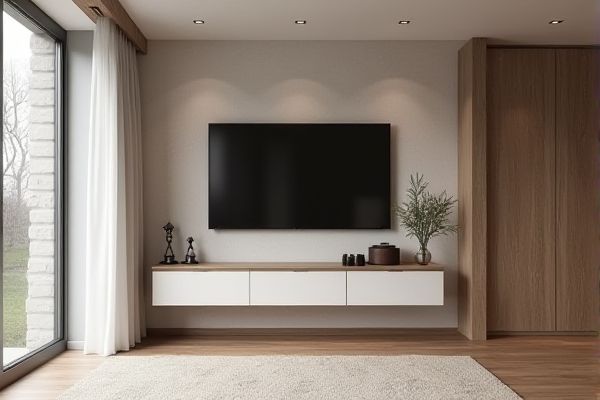
Floating cabinets maximize floor space and create a modern, airy look by mounting directly to the wall without legs, ideal for small or minimalist rooms. Understanding the key differences between floating and freestanding cabinets will help you choose the best option for your space; continue reading to explore their distinct advantages.
Table of Comparison
| Feature | Floating Cabinet | Freestanding Cabinet |
|---|---|---|
| Installation | Wall-mounted, requires professional installation | Placed on floor, easy to move and install |
| Space Usage | Frees floor space, ideal for small rooms | Occupies floor space, requires more room |
| Maintenance | Easier to clean underneath | Cleaning can be harder around base |
| Weight Capacity | Limited by wall strength | Supports heavier loads |
| Style | Modern, sleek look | Traditional and versatile designs |
| Durability | Depends on mounting hardware | Sturdy and stable |
Introduction to Floating and Freestanding Cabinets
Floating cabinets mount directly onto walls, offering a modern, space-saving design that creates the illusion of more floor area and simplifies cleaning underneath. Freestanding cabinets stand independently on the floor, providing versatile storage solutions with easy relocation options and a traditional aesthetic. Both cabinet types cater to different functional needs and design preferences in home or office environments.
Key Differences Between Floating and Freestanding Cabinets
Floating cabinets mount directly onto walls, creating a sleek, modern look while saving floor space and making cleaning underneath easier. Freestanding cabinets rest on the floor, offering greater storage capacity, easier relocation, and more traditional design versatility. Weight limits, installation complexity, and aesthetic preferences significantly influence the choice between floating and freestanding cabinets in both residential and commercial spaces.
Aesthetic Appeal: Modern vs Traditional Designs
Floating cabinets offer a sleek, modern aesthetic by creating a minimalist, wall-mounted look that enhances open space and contemporary interiors. Freestanding cabinets, with their classic design and solid base, provide a traditional charm and versatility that complements more conventional or rustic decor styles. Choosing between these options depends on the desired design impact, where floating cabinets suit modern elegance and freestanding units emphasize timeless, traditional appeal.
Space-Saving Benefits and Limitations
Floating cabinets maximize space by being wall-mounted, freeing up floor area for easier cleaning and a more open room feel. Freestanding cabinets offer versatile placement but consume valuable floor space, potentially limiting room movement. Your choice depends on whether you prioritize sleek, modern space-saving design or flexible, standalone storage options.
Installation Requirements and Complexity
Floating cabinets require secure wall mounting with studs and appropriate anchors, making installation more complex and time-consuming compared to freestanding cabinets. Freestanding cabinets need just a flat, level floor surface for placement without permanent attachments, simplifying setup and allowing easy relocation. Your choice impacts installation effort, with floating models demanding professional skills and precise measurements for stability.
Durability and Maintenance Comparison
Floating cabinets typically offer enhanced durability due to wall-mounted installation, which reduces direct contact with floor moisture and potential damage from spills or cleaning activities. Freestanding cabinets require more frequent maintenance as they rest on the floor, making them susceptible to water damage, scratches, and wear over time. Your choice should consider the ease of cleaning and resistance to environmental factors, with floating cabinets generally providing a longer-lasting, low-maintenance solution.
Storage Capacity and Practicality
Floating cabinets maximize floor space and create an airy, modern look while offering moderate storage capacity ideal for lightweight items. Freestanding cabinets provide greater storage capacity with multiple shelves and compartments, making them practical for heavier or bulkier items. Your choice depends on whether you prioritize sleek design with limited storage or versatile, ample storage for diverse needs.
Cost Analysis: Floating vs Freestanding Cabinets
Floating cabinets typically cost more upfront due to the need for reinforced wall mounting and specialized installation, whereas freestanding cabinets offer lower initial expenses with simpler setup. Maintenance costs for floating cabinets can be higher if wall repairs are needed, while freestanding units are easier and cheaper to move or replace without structural impact. Long-term cost efficiency depends on factors like kitchen layout and durability, but freestanding cabinets generally provide more budget-friendly flexibility.
Best Rooms and Applications for Each Type
Floating cabinets work best in modern bathrooms and kitchens where a sleek, minimalist look and easy floor cleaning are priorities; their wall-mounted design maximizes floor space and creates an airy feel. Freestanding cabinets are ideal for living rooms, bedrooms, and offices that require flexible storage solutions and frequent rearrangement, offering versatility and substantial storage capacity. Your choice depends on the room's style, space constraints, and whether you prioritize aesthetic integration or mobility.
Which Cabinet Style Suits Your Home?
Floating cabinets create a sleek, modern look by mounting directly on walls, maximizing floor space and making rooms appear larger, ideal for minimalist and contemporary interiors. Freestanding cabinets offer versatile placement and traditional style, providing ample storage and mobility, suitable for transitional or classic home designs. Choosing between floating and freestanding cabinets depends on your home's layout, aesthetic preference, and functional needs.
 homyna.com
homyna.com